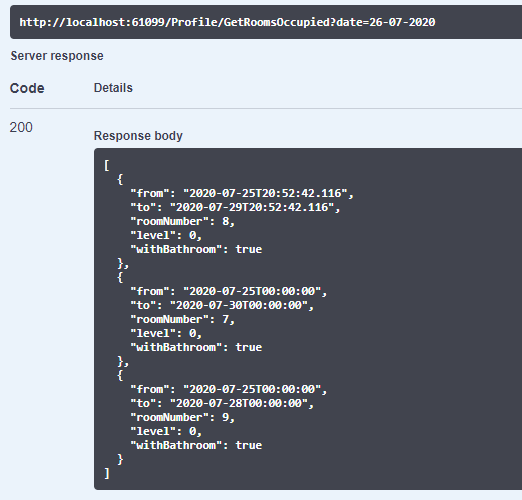Widok w kontekście baz danych jest wirtualną tabelą opartą na zestawie wyników uzyskanych przez wykonanie zapytaniem SQL. Są one zwykle używane jako obiekty tylko do odczytu, które są zoptymalizowane pod kątem dostarczania danych dla danego scenariusza. Entity Framework Core 5 obsługuje widoki, a w tym artykule pokażę, jak to działa.
Dodanie widoku
Pierwszą rzecz jaką musimy zrobić, to dodać widok do bazy danych. Najlepszym sposobem na to jest dodanie migracji bazy danych z odpowiednim kodem SQL. Zacznijmy od dodania migracji za pomocą polecenia narzędzia globalnego EF Core:
dotnet ef migrations add vwGuestArrivals
To polecenie wygeneruje migrację, w której możemy umieścić nasz SQL. Zobaczmy, jak to może wyglądać:
public partial class vwGuestArrivals : Migration
{
protected override void Up(MigrationBuilder migrationBuilder)
{
var sql = @"
CREATE OR ALTER VIEW [dbo].[vwRoomsOccupied] AS
SELECT r.[From], r.[To], ro.Number As RoomNumber, ro.Level, ro.WithBathroom
FROM Reservations r
JOIN Rooms ro ON r.RoomId = ro.Id";
migrationBuilder.Sql(sql);
}
protected override void Down(MigrationBuilder migrationBuilder)
{
migrationBuilder.Sql(@"DROP VIEW vwRoomsOccupied");
}
}
Ten widok przedstawia zajęte pokoje, które możemy filtrować według daty. Tego rodzaju dane mogą być przydatne na przykład podczas planowania konserwacji i prac remontowych.
Pobieranie danych z widoku
W Entity Framework Core 5 widoki mogą być reprezentowane jako zwykła kolekcja DbSet. W moim przypadku, aby zmapować wszystkie kolumny widoku, musimy stworzyć model RoomOcupied, który wygląda tak:
[Keyless]
public class RoomOccupied
{
public DateTime From { get; set; }
public DateTime To { get; set; }
public int RoomNumber { get; set; }
public int Level { get; set; }
public bool WithBathroom { get; set; }
}
Teraz musimy dodać DbSet do mojego PrimeDbContext i musimy skonfigurować nasz model, aby RoomsOccupied był wykonywany na konkretnym widoku. Zobaczmy, jak można to osiągnąć:
public class PrimeDbContext : DbContext
{
public PrimeDbContext(DbContextOptions<PrimeDbContext> options)
: base(options)
{
}
public virtual DbSet<RoomOccupied> RoomsOccupied { get; set; }
protected override void OnModelCreating(ModelBuilder modelBuilder)
{
modelBuilder
.Entity<RoomOccupied>(eb =>
{
eb.HasNoKey();
eb.ToView("vwRoomsOccupied");
});
}
}
Jak widać, jest to normalna kolekcja DbSet, na który można filtrować jak jak chcemy. Jest jednak drobiazg, który wyróżnia tę kolekcję. Zwróć uwagę, że konfigurujemy encję RoomOccupied tak, aby nie miała klucza. W ten sposób nie musimy mieć klucza w wyniku, ale oznacza to również, że byłby to model tylko do odczytu.
Obecnie Entity Framework Core 5 nie obsługuje aktualizowania widoku, chociaż jest to możliwe w bazie danych SQL Server. Możesz jednak zdefiniować widok, który posiada klucz. Pamiętaj tylko, aby usunąć HasNoKey w konfiguracji i atrybut [Keyless] w encji.
Użyjmy kodu, który właśnie napisaliśmy. Aby to zrobić w najprostszy możliwy sposób, dodałem metodę do mojego interfejsu API ASP.NET Core. Oto jak to wygląda:
[HttpGet("GetRoomsOccupied")]
public IActionResult GetGuestArrivalsFromView([FromQuery] string date)
{
var parsedDate = DateTime.ParseExact(date, "dd-MM-yyyy", CultureInfo.InvariantCulture);
var rooms = primeDbContext.RoomsOccupied.Where(r => r.From <= parsedDate && r.To >= parsedDate);
return Ok(rooms);
}
Tutaj podaję datę w formacie dd-MM-rrrr i pytam o wszystkie pokoje zajęte w tym dniu. Oto wynik.

Używam vwRoomsOccupied i wykonuje zapytanie SQL z zastosowanymi wszystkimi filtrami. W SQL Server Profiler możemy spojrzeć na SQL, który został wykonany.

Zauważ, że w tym przykładzie używamy tylko dat bez czasu i wszystko działa dobrze. Jeśli jednak chcesz porównać również daty z czasem, musisz zastosować nieco inne podejście.
Podsumowanie
Entity Framework Core 5 bezbłędnie obsługuje widoki. Musisz go skonfigurować w swojej klasie DbContext i określić, że określona jednostka zostanie zamapowana na widok. Gdy to zrobisz, możesz użyć DbSet, jak chcesz, a wszystkie filtry zostaną zastosowane bezpośrednio do wygenerowanego kodu SQL.
Co więcej, możesz obsłużyć dodawanie lub aktualizowanie widoku za pomocą migracji EF Core, co oznacza, że wszystkie wymagane prace można wykonać za pomocą EF Core.
Cały pokazany tutaj kod można znaleźć na moim GitHubie, możesz spokojnie z nim eksperymentować, zachętam!
